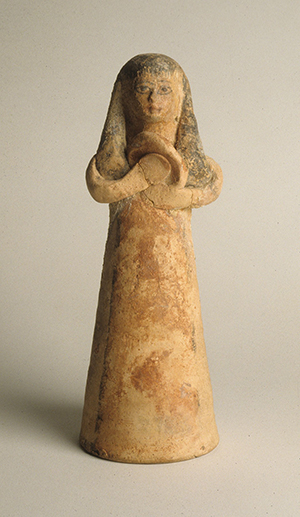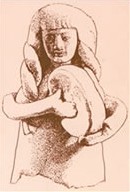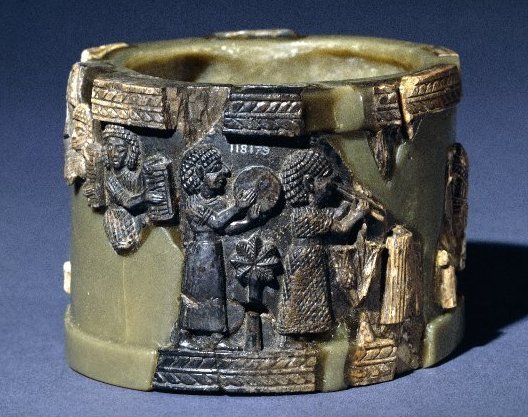 Edit article
Edit articleSeries
Miriam’s Song of the Sea: A Women’s Victory Performance

The Songs of Joy, James Tissot c. 1896-1902, thejewishmuseum.org
Shirat Hayam, “The Song of the Sea” (Exodus 15: 1b-18), is a poetic tribute to Israel’s miraculous deliverance from the pursuing Egyptians.[1] It is generally considered a very ancient poem, much older than (and somewhat different from) the preceding prose account of this pivotal event in the story of the Israelites escape from bondage in Egypt.[2]
In both form and content, it draws on the imagery of Canaanite mythology in which the heroic deity Baal overcomes primordial chaos, represented by surging waters, in order to establish order. The military imagery of the cosmic struggle in the Ugaritic epic reverberates in the Israelite poem; natural elements (wind and water) become YHWH’s weapons against the Egyptian foes.
The divine warrior trope of Canaanite epic is quite explicit: YHWH is metaphorically called אִישׁ מִלְחָמָה, a warrior (verse 3, MT)[3] who subdues the enemy with a sword (חרב, verse 9). Unlike Canaanite myth, YHWH smites human enemies, not the waters.
The Two (?) Songs of the Sea
This hymnic account of the deliverance at the sea is preceded by a brief introduction:
שמות טו:א אָז יָשִׁיר מֹשֶׁה וּבְנֵי יִשְׂרָאֵל אֶת הַשִּׁירָה הַזֹּאת לַי־הוָה וַיֹּאמְרוּ לֵאמֹר
Exod 15:1 Then Moses and the Israelites sang this song to YHWH. They said…
Thus, the song is often called “The Song of Moses,” a designation otherwise used for the poem in Deuteronomy 32, typically named after its first Hebrew word, Ha’azinu, “Give Ear.” The song is followed by a single-verse prose summation,[4] following which is another brief prose section, also introducing a poem:
שמות טו:כ וַתִּקַּח מִרְיָם הַנְּבִיאָה אֲחוֹת אַהֲרֹן אֶת הַתֹּף בְּיָדָהּ וַתֵּצֶאןָ כָל הַנָּשִׁים אַחֲרֶיהָ בְּתֻפִּים וּבִמְחֹלֹת. טו:כא וַתַּעַן לָהֶם מִרְיָם...
Exod 15:20 Then Miriam the prophet, Aaron’s sister, picked up a hand-drum,[5] and all the women went out after her in dance with hand-drums. 15:21 And Miriam chanted for them…
And the poem she chants, often called the Song of Miriam, echoes the first verse of the Song of the Sea:
Moses Song (Exod 15:1b)
אָשִׁירָה לַי־הוָה
כִּי גָאֹה גָּאָה
סוּס וְרֹכְבוֹ רָמָה בַיָּם
I shall sing to YHWH
for he has triumphed gloriously;
Horse and driver he has hurled into the sea.
Miriam’s Song (Exod 15:21b)
שִׁירוּ לַי־הוָה
כִּי גָאֹה גָּאָה
סוּס וְרֹכְבוֹ רָמָה בַיָּם
Sing to YHWH
for he has triumphed gloriously;
Horse and driver he has hurled into the sea.
In both cases, this couplet is likely to be the title of the poem as well as the opening line, in accordance with the ancient Semitic practice of titling poems or other literary works by their first words or line. But, while the full poem appears in verses 1b–18, verse 21 only references the first line, i.e., the title, which arguably represents the entire poem. For example, in antiquity the Gilgamesh Epic was called “He who saw everything,” which is how the epic begins.
However, in a set of fragments from the Dead Sea Scrolls called the Reworked Pentateuch (specifically, 4Q365/4QRPc), dating to 75–50 BCE, seven incomplete lines of a different poetic text have survived as Miriam’s Song and represent the survival of at least one tradition preserving Miriam’s own song, separate from that of Moses.[6]
Who Wrote the Song of the Sea?
Exodus attributes the poem to Moses, with Miriam’s rendition considered an antiphonal response. But a number of considerations support the possibility that, from a tradition historical perspective, the poem was Miriam’s before it was Moses’.
First, whereas the poem begins with the first-person verb, אָשִׁירָה “I will sing,” the prose introduction says that “Moses and the Israelites,” not Moses alone, sang the song. Moreover, it refers to הַשִּׁירָה הַזֹּאת “this song”—not “his song” or “Moses’ song.” Thus, the biblical text itself is not so clear about attribution.
Secondly, the view that Exodus 15:21 is antiphonal is based on the assumption that the verb introducing the poetic snippet in verse 21 means “answer.” However, the verb there, וַתַּעַן, may be a merger of proto-Semitic *ʿny, “answer,” and *ǵny, “sing” (like Arabic ǵny and Syriac ‘ny) and often refers to music or singing (e.g., Numbers 21:17). Moreover, the Greek translation (Septuagint) of Exodus15:21 translates וַתַּעַן as “led them in song.”[7] Thus what Miriam sings is not characterized as an antiphonal answer but rather her own song.
In fact, more than half a century ago, two leading biblical scholars, Frank Moore Cross and David Noel Freedman, both experts in biblical poetry, argued that the [long] hymn in Exodus 15 should be designated “The Song of Miriam.” They hold the ascription to her in Exodus 15:20–21 as superior and assert that it is easier to conceive of the long poem being re-attributed to a great leader (Moses) than to “explain the association with Miriam being secondary.”[8]
These points, as well as the existence of a Dead Sea Scroll fragment attributing an extended song to Miriam, suggest that the Song of the Sea should really be attributed to Miriam.[9] Indeed, the very presence of the beginning (that is, the title) of Miriam’s song in the Masoretic Text indicates that the tradition of her authorship was so powerful that it could not be completely edited out, even as editors or redactors associated the entire poem with Moses to heighten his apotheosis.[10]
Genre and Performance: A Woman’s Song
Another reason to connect the Song of the Sea to Miriam is its genre as a woman’s song. The genre can be identified as a performance tradition characterized by three elements in 15:20: a song accompanied by hand-drum and dance (בְּתֻפִּים וּבִמְחֹלֹת). These three elements appear in several other biblical texts and one extra-biblical text—always with women as performers.
Jephthah’s Daughter Celebrates the Victory over the Ammonites—In Judges 11, Jephthah makes an oath that if he defeats the Ammonites, he will sacrifice whoever comes out of his house first, as such a victory would have been made possible because (verse 29) “the spirit of YHWH empowered Jephthah (וַתְּהִי עַל יִפְתָּח רוּחַ יְ־הוָה), and because (verse 32) “YHWH delivered them into his hands” (וַיִּתְּנֵם יְ־הוָה בְּיָדוֹ). The story then takes a tragic turn:
שופטים יא:לד וַיָּבֹא יִפְתָּח הַמִּצְפָּה אֶל בֵּיתוֹ וְהִנֵּה בִתּוֹ יֹצֵאת לִקְרָאתוֹ בְתֻפִּים וּבִמְחֹלוֹת...
Judg 11:34 When Jephthah arrived at his home in Mizpah, there was his daughter coming out to meet him, with hand-drum and dance!
She is performing this dance (and presumably song), in celebration of the otherwise improbable Israelite victory.[11]
Israelite Women Celebrate David and Saul’s Victories over the Philistines—Another celebratory performance appears in 1 Samuel 18 in a narrative about David before he becomes king. At Saul’s behest David successfully overcomes the vaunted Philistine forces (verse 5), after which:
שמואל א יח:ו וַיְהִי בְּבוֹאָם בְּשׁוּב דָּוִד מֵהַכּוֹת אֶת הַפְּלִשְׁתִּי וַתֵּצֶאנָה הַנָּשִׁים מִכָּל עָרֵי יִשְׂרָאֵל (לשור) [לָשִׁיר] וְהַמְּחֹלוֹת לִקְרַאת שָׁאוּל הַמֶּלֶךְ בְּתֻפִּים בְּשִׂמְחָה וּבְשָׁלִשִׁים. יח:ז וַתַּעֲנֶינָה הַנָּשִׁים הַמְשַׂחֲקוֹת וַתֹּאמַרְןָ הִכָּה שָׁאוּל (באלפו) [בַּאֲלָפָיו] וְדָוִד בְּרִבְבֹתָיו.
1 Sam 18:6 When the troops came home and David returned from killing the Philistine, the women of all the towns of Israel came out singing and dancing to greet King Saul with hand-drums, shouting, and sistrums. 18:7 The women sang as they danced, and they chanted: “Saul has slain his thousands; David, his tens of thousands!”
Again, we have women dancing, singing, and playing musical instruments to celebrate an Israelite victory.
Deborah’s Song—Judges 5:1, a celebratory poem commemorating the Israelite victory over Sisera, general of the Canaanite forces, is another example. This ancient poem is often called the Song of Deborah. Although the prose introduction to the song has Barak singing along with her, the poem is presented in the first person singular and Deborah references herself in verse 8. Later in the song, the division between Deborah as singer and Barak as conqueror is made explicit:
שופטים ה:יב עוּרִי עוּרִי דְּבוֹרָה עוּרִי עוּרִי דַּבְּרִי שִׁיר קוּם בָּרָק וּשֲׁבֵה שֶׁבְיְךָ בֶּן אֲבִינֹעַם.
Judg 5:12 Awake, awake, O Deborah! Awake, awake, strike up the chant! Arise, O Barak; Take your captives, O son of Abinoam!
The poem never says that Deborah is playing music or dancing, but the very fact of a woman singing a victory song elliptically invokes the image of drum and dance accompanying the song.
Personified Israel—Jeremiah 31, an oracle of hope and consolation to the survivors of the destruction of Judah and Jerusalem, describes a personified Israel as a young woman who goes out with hand-drums and dancing in celebration:
ירמיה לא:ד עוֹד אֶבְנֵךְ וְנִבְנֵית בְּתוּלַת יִשְׂרָאֵל עוֹד תַּעְדִּי תֻפַּיִךְ וְיָצָאת בִּמְחוֹל מְשַׂחֲקִים.
Jer 31:4 I will build you firmly again, O Maiden Israel! Again you shall take up your hand-drums and go forth to the rhythm of the dancers.
This is not exactly a military victory, but it does attribute the similarly joyful return from exile to God’s power.
Judith Celebrate the Defeat of the Assyrians—In the ancient Jewish novel about Judith and her heroic deeds,[12] Judith saves her people by beheading the enemy general Holofernes (Judith 13–15) in a manner reminiscent of the Deborah narrative.[13] As in the Hebrew-Bible examples considered here, Judith leads all the women, with dance and hand-drums:
Judith 15:12 And every woman of Israel rushed together so as to see her, and they blessed her, and some of them performed a choral dance for her, and she took wands in her hands and gave them to the women who were with her. 15:13 … and she went before all the people leading all the women in dancing, and every man of Israel, vested in armor, was following along with crowns, and they were singing hymns with their mouth.[14]
Judith then sings a long poem (16:1–17) celebrating victory over the mighty Assyrians because of God’s intervention, at the hand of a woman, which begins thus:
Judith 15:14 And Judith began this confession in the midst of all Israel, and all the people were singing out this praise. 16:1 And Judith said:
Address my God with hand-drums;
Sing to the Lord with cymbals.
Adapt a tune and a song of praise for him;
Exalt and invoke his name.[15]
Judith’s leading of women in a victory song is reminiscent of Miriam’s act in Exodus 15 and was likely composed with this account in mind.
A Woman’s Tradition
Taken together, these texts specifying drum-dance-song performance represent a distinct women’s tradition. Even when all three of these elements are not mentioned, the presence of all three would have been understood. Indeed, studies of traditional songs suggest an organic performance tradition, with movement (dance) and rhythm (drums) along with words constituting a compositional whole.[16]
In this case—the Song of Miriam and similar texts involving dancing, drums, and song—the performance genre is a victory-song tradition associated specifically with women. Women are the ones left behind when armies go out to battle, and thus they are the ones to celebrate the return of warriors.[17] In its ancient cultural context, the Song of the Sea would have been sung by women—Miriam and her cohort—celebrating YHWH’s defeat of Israel’s enemies. In fact, from the accounts of Miriam, Deborah, Jephthah’s daughter, and Judith, we get a picture of women as leaders of musical groups.
Women and Drums
Consideration of the vocabulary for musical instruments in the Hebrew Bible sheds additional light on this genre and on women’s role as musicians, specifically drummers. The Hebrew Bible actually has a rich vocabulary of musical terms, especially ones denoting musical instruments. Musicologists have divided them into four categories,[18] listed here with the number of different types mentioned in the Hebrew Bible:
- Chordophones: stringed instruments; at least nine different ones (e.g., kinnor, lyre).[19]
- Aerophones: wind instruments; about a dozen of these (e.g., shophar, horn).[20]
- Idiophones: instruments that produce sound when parts of it strike each other; five examples (e.g., pa‘amonim, small bells).[21]
- Membranophones; percussion instruments: only one, the toph (hand-drum or frame drum), likely the oldest type of musical instrument.
The appearance of only one membranophone in the Bible, the hand-drum (toph), means that virtually every musical performance involved that instrument, for the beat of a percussion instrument was a fundamental part of any musical performance. And who played the drums in ancient Israel?
Although the Bible mentions nearly thirty different instruments, the gender of the musician playing them is noted only for hand-drums. This appear in the victory-song passages and in Psalm 68, in which a procession to the temple includes singers, musicians, and young women playing hand-drums.[22]
תהלים סח:כו קִדְּמוּ שָׁרִים אַחַר נֹגְנִים בְּתוֹךְ עֲלָמוֹת תּוֹפֵפוֹת.
Ps 68:26 First come singers, then musicians, amidst maidens playing hand-drums.
Moreover, of the sixteen times the hand-drum appears in the Hebrew Bible, only five times does the text mention the musicians, and in all cases they are women.
A Woman’s Dance
Just as the hand-drum seems to have been a woman’s instrument, the Hebrew root ח.ו.ל, used for dance in the passages reporting women’s drum, dance, and song (Exodus 15:20; Judges 11:34; 1 Samuel 18:6; and Jeremiah 31:4), seems to refer to a women’s dance.
We see this root again in reference to the Shulamite woman in the Song of Songs:
שיר השירים ז:א מַה תֶּחֱזוּ בַּשּׁוּלַמִּית כִּמְחֹלַת הַמַּחֲנָיִם.
Song 7:1 Why will you gaze at the Shulammite in the Mahanaim dance?"
Elsewhere, when men are dancing, the root is ר.ק.ד (e.g., 1 Chronicles 15:29).[23] Women apparently moved horizontally in a specific kind of dance, likely a circle dance, whereas men moved vertically, leaping up and down.[24]
Women and Their Drums: Archaeological Evidence
The connection between women (not men!) and drums is supported by archaeological evidence. Small clay figurines have been recovered at virtually every Iron Age site in the East Mediterranean. Many of them represent animals, but figurines representing humans are also common.[25] A subset of the terracotta renderings of humans are those depicting musicians playing flutes, cymbals, lyres, and hand-drums.[26] Nearly forty of the figurines of musicians depict drum-players, and to the best of my knowledge, virtually all of those percussionists are women.[27]

|

|
Today men dominate as percussionists; not so in the ancient Levant, where women were the drum players as sole accompanists to musical performances or as part of small ensembles of musicians. Women-only ensembles appear in the archaeological record in the form of a small ivory pyxis (cylindrical box with a lid, usually to hold cosmetics, jewelry, or other trinkets), dating to the Iron II period, discovered at Nimrud but probably originating in the Levant. It shows a procession of women musicians with a hand-drum player in the middle.[28] A similar scene appears on an early seventh-century BCE silver bowl discovered in Cyprus but probably made by an artist from the Levant.[29]

Concluding Comments
In sum, because only women played the toph, all the biblical passages that mention performances involving drums and other instruments must denote ensembles that were either all female (as when dance, using ח.ו.ל, is also mentioned; see Psalms 149:3; 150:4) or were mixed gender.[30] In the former case, when practicing together, women formed groups and provided opportunities for women leaders.
The Song of the Sea is a prominent biblical example of a woman’s performance genre. Its attribution to Miriam means that this powerful and perhaps earliest message about God’s power used to save the people is given voice by a woman.
The placement of Miriam’s song after the full version associated with Moses may seem to cede unwarranted credit to the male leader, but at the same time it forms the literary function of enveloping the first major section of the book of Exodus (Exodus 1–15:21) within woman-centered texts—from the twelve women who figure prominently in the opening chapters of Exodus (Shiphrah, Puah, Moses’ mother, his sister [Miriam], Pharaoh’s daughter, and the seven daughters of the priest of Midian)—to the ringing words of Miriam in Exodus 15.[31]
TheTorah.com is a 501(c)(3) nonprofit organization.
We rely on the support of readers like you. Please support us.
Published
February 6, 2020
|
Last Updated
December 1, 2025
Previous in the Series
Next in the Series
Before you continue...
Thank you to all our readers who offered their year-end support.
Please help TheTorah.com get off to a strong start in 2025.
Footnotes

Prof. Carol Meyers is the Mary Grace Wilson Professor (Emerita) in the Religious Studies Department at Duke University. She received her A.B. in Bible from Wellesley College and her M.A. and Ph.D. in Near Eastern and Judaic Studies from Brandeis University. Her reference work, Women in Scripture, is a comprehensive look at all biblical women; and her book Rediscovering Eve is a detailed study of women in ancient Israel. She has co-authored (with Eric Meyers) two Anchor Bible commentaries (on Haggai and Zechariah) and also several major archaeological reports. She has been a staff member or co-director of numerous archaeological field projects, served as president of the Society of Biblical Literature and is currently a trustee of the American Schools of Oriental Research, the Albright Institute of Archaeological Research, and the Dead Sea Scrolls Foundation.
Essays on Related Topics:









